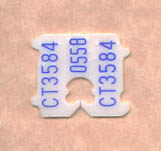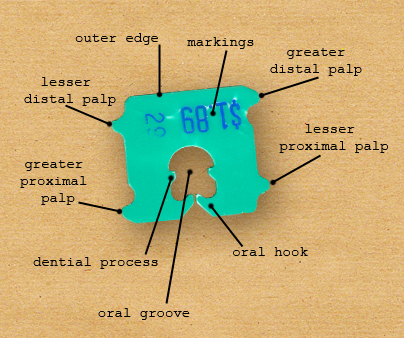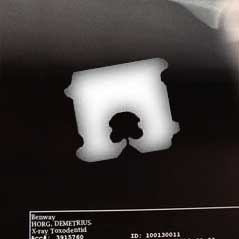Occlupanids are totally adapted to a life of parasitism. Ranging from 2-3cm to 5cm, they are dorsoventrally flattened for ease of moving between the folds of plastic on which they live. The principal feature of an occlupanid is its ‘oral groove’, an invagination in what we’re pretty sure is the anterior region of the body. Two inward-curving hooks of plastic surround a small area within, sometimes lined with smaller notches or tabs for increased grippage onto their host substrate.
The outside (or ‘edge’) of the occlupanid is often smooth, but many species sport palps, or tabs. These have unguessable purposes for mating, locomotion, defense, take your pick.
 Occlupanids come in a staggering variety of colors; bright red, brilliant yellow, and golden brown to name a few. Many of these plasticae sport a dizzying array of markings; often spelling out cryptic phrases like “SellByJUN02” and “MFG 10996C”. Field observation has determined that these markings are used to identify an occlupanid as part of a group, though what purpose a parasite has for a tribe is unclear. Some researchers believe that these markings are genetic ‘fingerprints’ and record them for purposes of lineage and distribution. These are the researchers who have the most free time on their hands, it should be mentioned.
Occlupanids come in a staggering variety of colors; bright red, brilliant yellow, and golden brown to name a few. Many of these plasticae sport a dizzying array of markings; often spelling out cryptic phrases like “SellByJUN02” and “MFG 10996C”. Field observation has determined that these markings are used to identify an occlupanid as part of a group, though what purpose a parasite has for a tribe is unclear. Some researchers believe that these markings are genetic ‘fingerprints’ and record them for purposes of lineage and distribution. These are the researchers who have the most free time on their hands, it should be mentioned.
All dissection and radiographic attempts have so far indicated that the body is uniformly composed of a stiff, yet flexible plastic. Although some researchers have performed experiments to determine the breaking point of this substance, these were denounced some years ago as being cruel and pointless, and have since been abandoned. Suffice to say, a loss of one of these hooks spells doom for the occlupanid.

